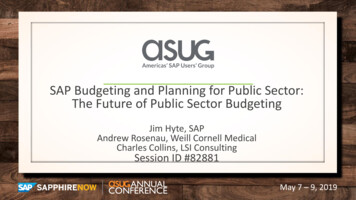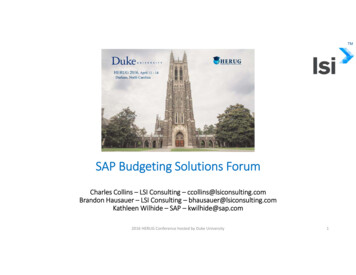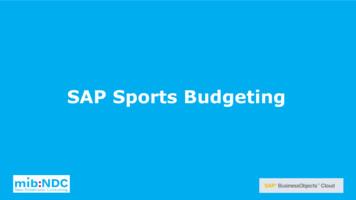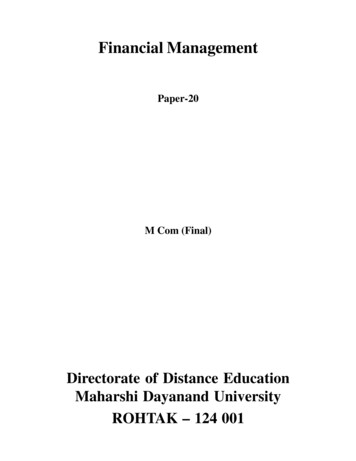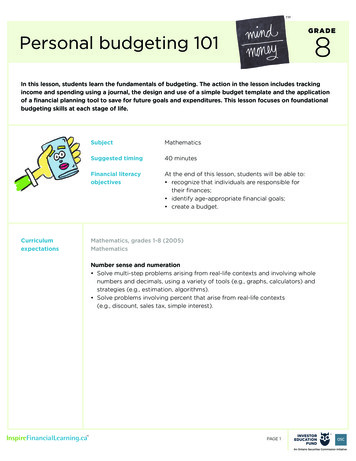
Transcription
GRADE8Personal budgeting 101In this lesson, students learn the fundamentals of budgeting. The action in the lesson includes trackingincome and spending using a journal, the design and use of a simple budget template and the applicationof a financial planning tool to save for future goals and expenditures. This lesson focuses on foundationalbudgeting skills at each stage of sted timing40 minutesFinancial literacyobjectivesAt the end of this lesson, students will be able to: recognize that individuals are responsible fortheir finances; identify age-appropriate financial goals; create a budget.Mathematics, grades 1-8 (2005)MathematicsNumber sense and numeration Solve multi-step problems arising from real-life contexts and involving wholenumbers and decimals, using a variety of tools (e.g., graphs, calculators) andstrategies (e.g., estimation, algorithms). Solve problems involving percent that arise from real-life contexts(e.g., discount, sales tax, simple interest).PAGE 1
Personal budgeting 101GRADE 8AssessmentCollect: budget templates.What you need Minds onDistribute how spending patterns change throughout our lives (Appendix A).Chart paperMarkersComputer lab (optional)How spending patterns change throughout our Lives (Appendix A)Budget journal worksheet (Appendix B)Personal budget exemplar (Appendix C)Personal budget worksheet (Appendix D)Spreadsheet template or spreadsheet program (optional)BrainstormingAsk students to compare various items that people are likely to spend money on ateach stage of life (e.g., children, teenagers, young adults, adults and seniors).Ask for volunteers to share their ideas by recording items on chart paper.Alternately, have volunteers write this information under life stage headings onthe board.Explain that each life stage incurs different kinds of expenses. Emphasize the onefactor common to all life stages: the need to control and analyze spending to ensurethe income we bring in adequately covers our costs of living and other expenditures.Take a class poll to determine the number of students who consistently recordor write down everything they spend money on. Additionally, ask if there are anystudents who already use a budget to help them control their spending. For thosestudents that do track spending, enquire about their process.Metaphor strategyStudents likely feel that creating and maintaining a budget is about as enjoyableas a trip to the dentist. Tell them that this is normal and remind them that evidencesuggests people who attend to their teeth have better hygiene and overall health.Likewise, people who attend to their finances by creating a budget and keeping trackof spending are in a better position to make decisions, to plan for the future and toexperience a sense of security.Explain to students that in order to live a life that is balanced and financially stable,it is critical to be aware and in control of what is coming in and going out of theirbank accounts. This is not something to fear; rather, it is a skill that will empowerthem to reach their goals and achieve financial stability and success.Explain that the purpose of this lesson is to show students a budgeting process theycan use and expand upon throughout each stage of their lives.PAGE 2
Personal budgeting 101ActionGRADE 8InstructionsDescribe the basics of the budgeting process by explaining that this budgetingprocess involves 3 simple steps:1. Itemize spending: This step involves documenting what you earn and what youspend by recording each item in a journal on a daily, weekly, and/or monthly basisand recognizing which expenses are needs and which are wants.2. Evaluate spending: This step involves determining where money is spent bycategorizing or grouping expenditures (e.g., food, transportation, etc.) andcomparing actual expenditures to budget targets.3. Planning for the future: This final step involves learning how to set limits onyour spending categories, how to create a plan to account for any unforeseenemergency expenditures and how to prepare for future goals or dreams.Explain that once the budgeting process becomes routine, it takes only a fewminutes each week to update your budget template and to stay on track for the restof your life.Activity: Applying the steps in budgetingInput income and spending in a journal.Explain to students that the first step in the process of budgeting is to keep a journalof all transactions. This is the “input” stage and includes recording expenses on oraround the date they occur. It also involves recording any income received.Explain that this is a simple and easy process but, like brushing your teeth daily,something that must be done on a regular basis so that it does not become anoverwhelming burden.PAGE 3
Personal budgeting 101Action(cont’d)GRADE 8ModellingModel the input step by opening up a shoebox or wallet containing a variety ofreceipts. Show students how to record expenses and income in a journal (Appendix B).Make it clear that what you are presenting is just one way of journalizing and explainthat individuals may want to record income and expenses in a way that works bestfor them. These processes can include:1. Keeping all receipts in a safe place (e.g., a shoebox, file folder or online database)and recording/inputting information into a journal at the end of the month.2. Recording each expense as it happens by writing the amount received or spent ina small pocket book or journal that you keep with you at all times.3. Using a digital device such as a cell phone to keep track of each purchase as it ismade.4. Using spreadsheet or an online tracking program that breaks down expenses andincome into graphs and charts.Demonstrate to students different filing systems that individuals use to keep theirreceipts and pay stubs organized (e.g., filing receipts in folders by month or bytype of expense, keeping all income amounts separate from expense amounts andorganizing these by month; keeping journal paper templates handy for recording andinputting information).Using the journal template (Appendix B), have students practise inputtinginformation from the various receipts that you pull from the shoebox. Encouragestudents to identify whether an item is a need or a want. Also have them record anyincome received.PAGE 4
Personal budgeting 101Action(cont’d)GRADE 8Evaluate spending patternsThe next step in any budgeting process is to evaluate what you spent money on overa set period of time by looking carefully at all of the expenses in your journal andplacing those expenses into categories.Explain to students that these categories will be different for each individual duringthe various life stages. Refer to the Minds on activity, which emphasizes the factthat adults and teens will likely have different expenditures and different budgetcategories.Encourage students to review their journal and assign items to categories of expense.Provide example categories for students to use, if needed (e.g., food, clothing,transportation, cell phone, etc.).Define a budget template by showing an exemplar of a completed budget template(Appendix C). Show the template on screen or on a Smart Board and have studentslabel all components of the template to ensure that they understand the function ofeach section of the document.Take extra time to explain the 2 critical budget template categories that will assistthem throughout their lives in making decisions about spending. These categories arethe budgeted amount (the limit that the individual places on spending for each item ineach category based on income) and the actual expense incurred during that period.Explain how comparing budget amount against amount spent will assist students inplanning income and expenses over time.Guided practiceHave students transfer the expense categories from their journal to the blank budgettemplate (e.g., cell phone, food, transportation, school supplies, entertainment, etc.)and then have them record the amounts of the expense on the template in thecorrect category.For this exercise, provide students with a budget amount and actual income amountand explain how to predict income for a given period based on a pay stub. Helpstudents understand the timing involved; that is, when the budgeting number andactual number are filled out during the month.Explain to students that as they use the budget template each month, patterns willemerge and they will begin to predict how much money they are earning and howmuch money they can budget for in each category.Show students how to add up and compare the budget totals to the actual totalsand explain the surplus and deficit columns. Demonstrate how to calculate the totals.(See Appendix C for an example.)PAGE 5
Personal budgeting 101Action(cont’d)GRADE 8Future planningExplain that the final step in the budgeting process involves developing a plan. Somepeople prefer to create a separate section for future goal planning (see Appendix C).If there are certain things you want in the future – go to university, buy a car or go ona vacation – it is essential to save for those things. While everyone’s goals and wantsare different, you can use this tool to plan your finances in order to attain what youwant or need.Explain how planning for the future involves figuring out if you have a budget surplusor deficit. If you have a deficit, spending must be cut in each of the categories beforeyou can start setting goals. If you have a surplus, you have an opportunity to decidehow much you want to save each month toward that goal. This will allow you topredict how long it will take to reach your financial aim.Ask students to experiment with setting a goal (e.g., schooling, vacation, etc.). Havethem allocate an amount using the savings goals template and evaluate where theycould set limits on each category of the budget to reduce their expenses and savefor the future.Consolidation/debriefAsk students to track spending in their journal over a one month period. At the endof that month, help them to create a budget for the following month using a newblank template or spreadsheet program.Discuss the following:1. How can identifying needs and wants within each budget category help youdetermine where spending can be reduced?2. Describe the importance of a budget.3. What are the consequences of running a deficit budget?4. When you hear governments talk about deficit budgets for the province orcountry, what would you advise them to do?5. How might your budget template change as you get older?PAGE 6
APPENDIX APersonal budgeting 101GRADE 8How spending patterns change throughout our livesHow might spending habits and expenses change throughout the life cycle? Record your ideas.Life stageExamples of typical expenses for the life stageChildrenTeenagersYoung adultsAdultsSeniorsPAGE 7
APPENDIX BPersonal budgeting 101GRADE 8Budget journal worksheetDate: FromtoInstructions: Use this sheet to journalize each expense that you make.DateExpenseCostWantJan. 6 2013Movies 10XNeedBudget categoryNotes for savingEntertainmentI noticed I can savemoney if I see an earlyshow or go on Tuesdayswhen prices are lower.PAGE 8
APPENDIX CPersonal budgeting 101GRADE 8Personal budget exemplarJen LamPersonal monthly budgetJan. 1- Jan. 31, 2013The “Budget” column is completedprior to the start of the month.The “Actual” column iscompleted at the end of themonth when you receive yourpay or total all expenses fromyour journal in a given sit 48( 12/week) 48 0Part-time job 120( 30/week) 140 20Other (gifts, etc.) 20 0( 20)Income totals 188 188 0Orange juice 4 4 0Salad 5 10( 5)Pita 10 15( 5)Shoes 60 0 60T-shirts 10 20( 10)Cell phoneMonthly bill 35 35 0EntertainmentMovie tickets 20 25( 5)Writing instruments 3 3 0Binders 5 5 0Bus pass 10 10 0Subway 6 10( 4)Alarm clock 15 15 0Posters 5 5 0Expense totals 188 157Budgeted surplus/(deficit) 0EXPENSESFoodClothingSchool suppliesTransportationOtherTotal actual surplus/(deficit) 31PAGE 9
APPENDIX CPersonal budgeting 101GRADE 8Personal budget exemplar (cont’d)Planning for future expensesThe 31 that you had left over at the end of this month can go to your “Future Expense Goal” and/or tosavings.Future expense goalExpenseMonthSavings to dateGo on a trip to NYC 1000January 31FebruaryMarchAprilTotal savings to datePAGE 10 31
APPENDIX DPersonal budgeting 101GRADE 8Personal budget worksheetPersonal monthly budgetName:Date:INCOMEBudgetActualIncome totalsEXPENSESFoodClothingCell PhoneEntertainmentSchool suppliesTransportationOtherExpense totalsBudgeted surplus/(deficit)Total actual surplus/(deficit)PAGE 11Surplus/(deficit)
APPENDIX DPersonal budgeting 101GRADE 8Personal budget worksheet (cont’d)Future expense goalExpenseMonthSavings to emberOctoberNovemberDecemberTotal savings to datePAGE 12
Personal budgeting 101 GRADE8 In this lesson, students learn the fundamentals of budgeting. The action in the lesson includes tracking income and spending using a journal, the design and use of a simple budget template and the application of a financial planning tool to save for future goals and expenditures. This lesson focuses on foundational
